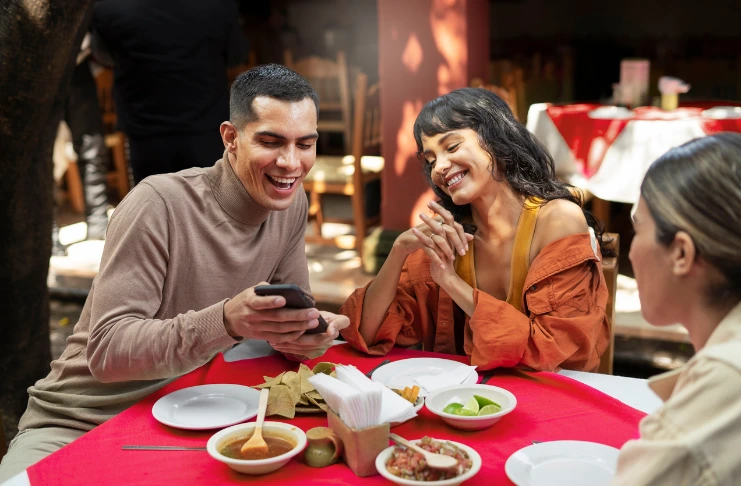In a world where a new dining option seems to emerge on every corner, what transforms a first-time visitor into a devoted regular? The answer lies not just in the perfection of your signature dish, but in the delicate art of customer loyalty.
In the fiercely competitive restaurant industry, winning a customer’s heart is just the beginning—keeping it requires strategy, consistency, and genuine connection, which can be effectively enhanced through customer loyalty programs. Loyal patrons represent far more than reliable revenue; they become the authentic voice of your brand in a marketplace increasingly skeptical of traditional advertising. When a loyal customer recommends your establishment to friends, that endorsement carries a credibility no marketing campaign can match.
This comprehensive guide pulls back the curtain on the psychology behind customer loyalty in the restaurant industry. We’ll explore why some establishments inspire fierce devotion while others—even those with exceptional cuisine—struggle to build a loyal following. From leveraging technology to create personalized experiences to training staff in the subtle art of recognition, we’ll examine proven strategies that transform casual diners into passionate advocates and learn how to increase customer loyalty in the process.
Whether you operate a neighborhood café, a bustling bistro, or a fine dining establishment, the principles of customer loyalty transcend culinary styles and price points. Join us as we navigate the essential ingredients for building lasting customer relationships in an industry where loyalty has never been more valuable—or more challenging to earn.
Understanding Customer Loyalty in Restaurants

Customer loyalty in the restaurant sector refers to patrons consistently choosing your establishment over competitors. This loyalty stems from positive experiences, satisfaction, and a strong emotional connection to your brand. Loyal customers are more likely to return, spend more, and recommend your restaurant to others, making them invaluable assets to your business.
The Importance of Customer Loyalty
Loyal customers are the heartbeat of any restaurant—driving repeat business, lowering marketing costs, and amplifying your brand through trusted word-of-mouth referrals.
INDUSTRY INSIGHTS
| In a highly competitive restaurant market, loyalty programs offer a proven way to boost customer retention and repeat business. And build lasting guest relationships. Recent data shows: 42.9% of consumers are motivated to try a restaurant because of its loyalty program. Loyal customers spend 67% more than new guests. 59% of U.S. customers say once a brand earns their loyalty, they stick with it for life. 86% of loyal guests will recommend your restaurant to friends and family. These numbers highlight how impactful loyalty programs can be in turning occasional diners into lifetime advocates. A single loyal customer can contribute more to your bottom line than several one-time diners. |
Moreover, focusing on customer retention makes solid business sense. According to the Harvard Business Review, attracting a new customer can cost five to 25 times more than retaining an existing one. By investing in loyalty-building initiatives, restaurants can significantly reduce marketing costs while boosting profits and customer lifetime value.
In short, customer loyalty isn’t just about appreciation—it’s a strategic asset that pays off in both brand equity and profitability.
Factors Influencing Restaurant Customer Loyalty

1. Food Quality
Consistently delivering high-quality, delicious food is fundamental to customer satisfaction and loyalty. A study conducted at Happy Tummy Resto Bar and Catering Services in Imus, Cavite, Philippines, evaluated customer experiences and satisfaction concerning customer service, facility cleanliness, value for money, and food quality. The findings indicated that, based on customer feedback, visitors were satisfied with the establishment’s food quality, among other factors, and exhibited loyalty towards the restaurant.
Additionally, research focusing on limited-service restaurants in Jordan found that both service and food quality positively influence customer satisfaction, especially in retaining existing customers. The study further confirmed that customer satisfaction mediates the relationship between service quality and customer retention, highlighting the critical role of food quality in fostering customer loyalty.
These studies underscore the importance of maintaining high food quality standards, to enhance customer satisfaction and encourage repeat patronage in the restaurant industry while also aiming to improve customer retention .
2. Service Excellence
Exceptional service enhances the dining experience, making customers feel valued and appreciated. Friendly, attentive, and knowledgeable staff can create a welcoming atmosphere that encourages repeat business. Training your team to provide personalized service and promptly address customer needs can significantly impact loyalty.
3. Ambience and Cleanliness
The restaurant’s environment plays a crucial role in shaping customer perceptions. A clean, comfortable, and aesthetically pleasing setting can enhance the overall dining experience. Factors such as lighting, music, seating arrangements, and decor contribute to creating an inviting atmosphere that encourages customers to return.
4. Price and Value Perception
Customers assess the value they receive based on the quality of food, service, and overall experience relative to the price paid. Offering fair pricing and delivering value can influence customers’ decisions to return. Implementing pricing strategies that reflect the quality and uniqueness of your offerings can enhance perceived value.
5. Convenience
Convenience factors, such as location, operating hours, and ease of reservation or ordering, significantly impact customer loyalty. Providing multiple channels for reservations and orders, including online platforms and mobile apps, can cater to customer preferences and enhance their overall experience.
Effective Restaurant Customer Retention Strategies

1. Implement Loyalty Programs
Loyalty programs incentivize repeat visits by rewarding customers for their continued patronage. According to a Deloitte survey, 47% of restaurant loyalty members use their memberships several times a month, and 32% do so several times a week. Designing a program that offers meaningful rewards, such as discounts, free items, or exclusive offers, can encourage customers to return.
2. Personalize Customer Experience
Personalization enhances customer engagement by making patrons feel recognized and valued. Utilizing customer data to tailor experiences, such as personalized greetings, remembering past orders, or offering customized recommendations, can deepen customer relationships and foster loyalty.
3. Engage Through Digital Channels
Leveraging digital platforms, including social media, email newsletters, and mobile apps, allows you to maintain regular communication with your customers. Sharing updates about new menu items, promotions, and events keeps your restaurant top-of-mind and encourages repeat visits.
4. Solicit and Act on Feedback
Encouraging customers to provide feedback demonstrates that you value their opinions and are committed to continuous improvement. Implementing changes based on customer suggestions can enhance satisfaction and show that you are responsive to their needs, strengthening loyalty.
5. Offer Exclusive Deals
Providing special offers or discounts to loyalty program customers feels appreciated and incentivizes repeat business. Exclusive deals can include birthday discounts, early access to new menu items, or members-only events, creating a sense of exclusivity and value.
Measuring Customer Retention

To ensure your retention efforts are effective and aligned with business goals, it’s essential to monitor specific performance metrics. Here are three key metrics every restaurant should track:
1. Customer Retention Rate (CRR)
Customer Retention Rate is the percentage of customers who continue to return to your restaurant over a defined period. It gives a clear indication of how well you’re maintaining relationships and delivering experiences that keep guests coming back. A high CRR typically means your service, food quality, and overall dining experience meet or exceed customer expectations. You can calculate it using the formula:
CRR = [(E – N) / S] × 100.
Where E is the number of customers at the end of a period, N is new customers gained during that period, and S is the number of customers at the start.
2. Repeat Purchase Rate
The Repeat Purchase Rate measures the proportion of customers who have made more than one transaction at your restaurant. This metric helps you understand how successful you are at converting one-time diners into loyal patrons. Tracking this consistently allows you to spot trends and gauge whether specific campaigns or promotions are driving return visits.
3. Customer Lifetime Value (CLV)
Customer Lifetime Value estimates the total revenue a restaurant can expect from a single customer throughout their entire relationship with the brand. This long-term view helps you assess the profitability of retaining customers versus acquiring new ones. By knowing your CLV, you can better allocate resources toward initiatives that foster long-term loyalty, such as rewards programs, personalized offers, or exceptional customer service. It also aids in forecasting future revenue and setting marketing budgets more strategically.
Regularly analyzing these metrics can help identify areas for improvement and measure the success of your loyalty initiatives.
Conclusion
Building and maintaining customer loyalty in the restaurant industry requires a multifaceted approach, focusing on quality, service, personalization, and engagement. While exceptional food remains foundational, it’s the complete dining experience that transforms first-time visitors into lifetime patrons.
As we’ve explored, loyalty isn’t simply earned once—it must be continuously nurtured. Every touchpoint presents an opportunity to strengthen the bond with your guests. The most successful restaurants view these moments not as transactions but as building blocks in an ongoing relationship.
Effective loyalty programs reflect your establishment’s unique identity rather than following generic templates. Your regulars return because you’ve created a space where they feel valued, recognized, and consistently delighted.
Each loyal customer becomes an extension of your marketing team, sharing authentic experiences that resonate with potential diners in ways traditional advertising cannot. Approach loyalty not as a campaign but as a culture that permeates every aspect of your operation.
By understanding the factors that influence loyalty and implementing effective retention strategies tailored to your concept and clientele, you can foster lasting relationships with your patrons, ensuring long-term success in an industry where genuine connection may be your most sustainable competitive advantage.
Frequently Asked Questions
1. What is customer loyalty in restaurants?
Customer loyalty in restaurants refers to guests consistently choosing and returning to the same restaurant due to satisfaction, trust, and positive experiences.
2. What are the 3 R’s of customer loyalty?
The 3 R’s of customer loyalty are Retention, Referrals, and Revenue, emphasizing the importance of keeping customers, encouraging word-of-mouth, and driving repeat sales.
3. What is restaurant loyalty?
Restaurant loyalty is the ongoing preference and repeated patronage of a restaurant by its customers, often fostered through good food, service, and rewards programs.
4. What restaurants have the best loyalty program?
Brands like Starbucks, Chick-fil-A, Domino’s, and Panera Bread are known for top-performing loyalty programs with personalized rewards and strong digital engagement.
5. What factors influence customer loyalty?
Key factors influencing customer loyalty include food quality, service consistency, price-value perception, ambience, and personalized customer experience.
6. What are at least 3 factors that influence brand loyalty?
Three major factors influencing brand loyalty are product quality, customer service, and emotional connection to the brand.
7. What are the factors influencing customers’ restaurant choice?
Customers choose restaurants based on food quality, menu variety, pricing, location, hygiene, online reviews, and service speed.
8. What are the factors influencing customer loyalty in the hospitality industry?
In hospitality, customer loyalty is influenced by service excellence, personalized guest experiences, brand trust, convenience, and consistent value delivery.
9. What are the 3 R’s of customer retention?
The three R’s of customer retention are Retention (keeping them), Recovery (winning them back), and Relationship (nurturing an ongoing connection).
10. How to save a customer in a restaurant?
To save a customer in a restaurant, listen actively to their concerns, respond promptly, offer sincere apologies or compensation, and follow up to restore trust.





